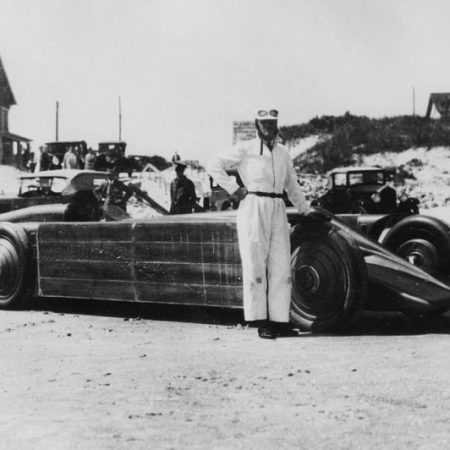The National Motor Museum is unique in that our collection includes four cars that have held the outright Land Speed Record. While all are remarkable, for many people it is the beautiful 1929 Irving Napier Special or ‘Golden Arrow’ that stands out. Backed by a consortium of leading British firms, the stunning aerodynamic car was driven by Major Henry Segrave to his third Land Speed Record at Daytona Beach on 11th March 1929, achieving a speed of 231.446mph.
While the car itself has been seen by many millions of visitors ever since it first went on display at Beaulieu in 1958, the National Motor Museum Trust will be reinterpreting this iconic vehicle through an Arts Council England funded project, The Golden Arrow – Shot from the Past, Aimed at the Future https://nationalmotormuseum.org.uk/golden-arrow-project/. In this project, we will tell the stories behind this truly iconic machine and the people associated with it using augmented reality and our historic collections. A new display, including a touch screen interactive, will explore the technical aspects of this amazing car which, despite its mechanical complexity and a tight time-scale, performed exactly as its designer Captain J.S. Irving predicted that it would. Drawing on material from our extensive library, archive and photographic collections we hope to present the story of Golden Arrow and the people who created it so that it may inspire a new generation of museum visitors.
For those unable to wait for the project to reach fruition you can get a taste of some of the related background stories about Sir Henry Segrave on the National Motor Museum Trust
For a summary of the work of the museum click HERE
Contributed by Patrick Collins
Research & Enquiries Officer
National Motor Museum Trust
The National Motor Museum is unique in that our collection includes four cars that have held the outright Land Speed Record. While all are remarkable, for many people it is the beautiful 1929 Irving Napier Special or ‘Golden Arrow’ that stands out. Backed by a consortium of leading British firms, the stunning aerodynamic car was driven by Major Henry Segrave to his third Land Speed Record at Daytona Beach on 11th March 1929, achieving a speed of 231.446mph.
While the car itself has been seen by many millions of visitors ever since it first went on display at Beaulieu in 1958, the National Motor Museum Trust will be reinterpreting this iconic vehicle through an Arts Council England funded project, The Golden Arrow – Shot from the Past, Aimed at the Future https://nationalmotormuseum.org.uk/golden-arrow-project/. In this project, we will tell the stories behind this truly iconic machine and the people associated with it using augmented reality and our historic collections. A new display, including a touch screen interactive, will explore the technical aspects of this amazing car which, despite its mechanical complexity and a tight time-scale, performed exactly as its designer Captain J.S. Irving predicted that it would. Drawing on material from our extensive library, archive and photographic collections we hope to present the story of Golden Arrow and the people who created it so that it may inspire a new generation of museum visitors.
For those unable to wait for the project to reach fruition you can get a taste of some of the related background stories about Sir Henry Segrave on the National Motor Museum Trust
For a summary of the work of the museum click HERE
Contributed by Patrick Collins
Research & Enquiries Officer
National Motor Museum Trust.

